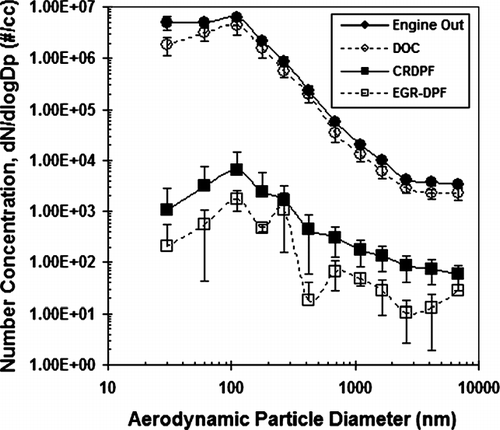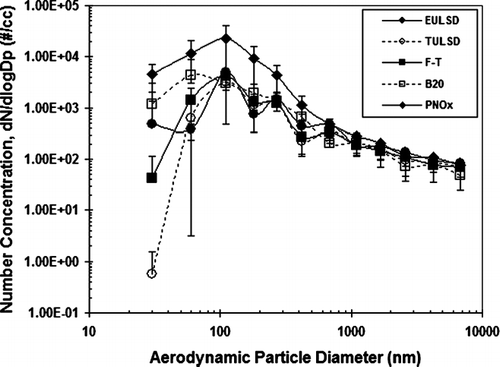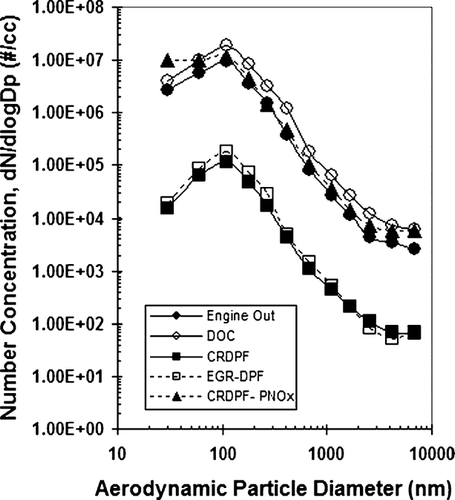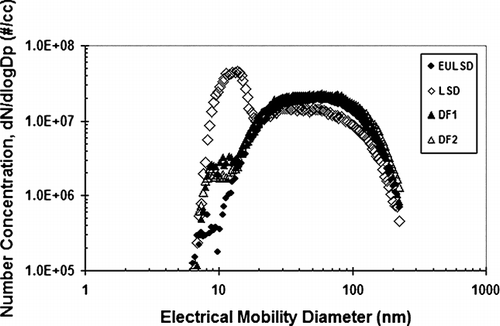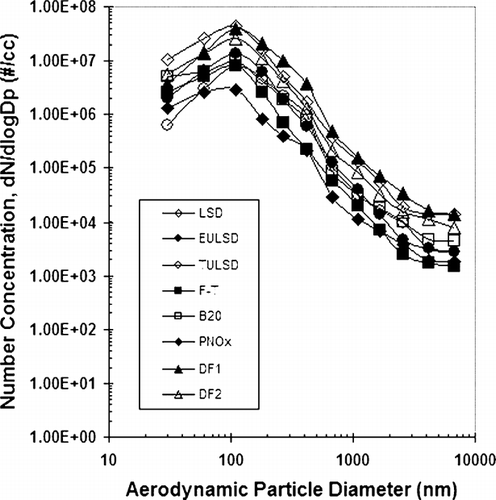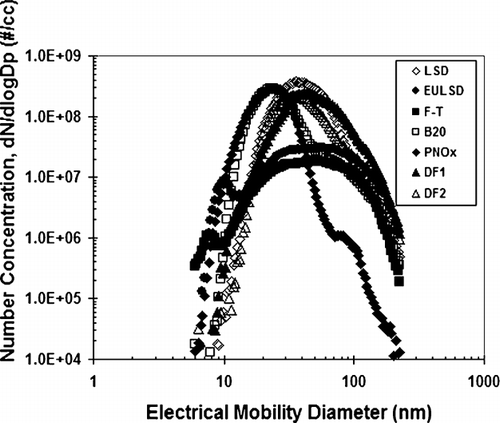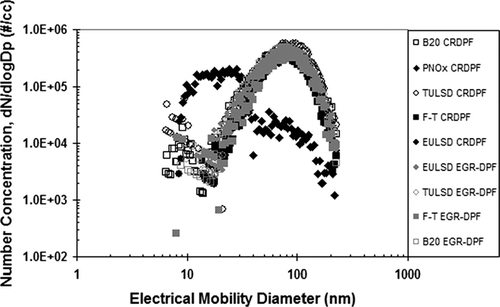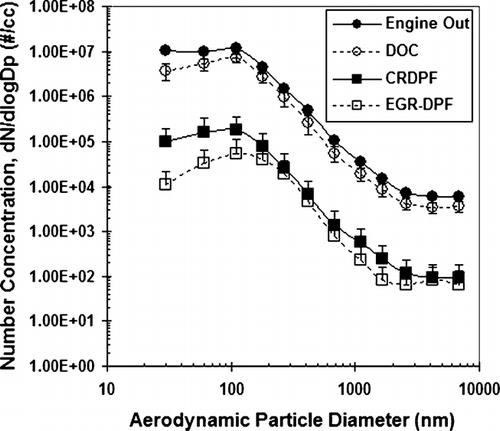Abstract
Two potential strategies for reducing diesel emissions are exhaust aftertreatment and the use of reformulated or alternative fuels. Little is yet known about the impact on ultrafine particle emissions of combining exhaust aftertreatment with such increasingly common fuels. This paper reports ultrafine particle size distribution measurements for a study in which the impact of such fuels on emissions from a heavy duty diesel engine employing different aftertreatment configurations was evaluated. Eight different fuels were tested: Canadian No. 1 and No. 2 diesel; low sulfur diesel fuel; two different ultra low sulfur diesel fuels (< 30 ppm S); Fischer-Tropsch diesel fuel; 20% biodiesel blended with ultra low sulfur diesel fuel; and PuriNOx™. The fuels were tested in combination with four exhaust configurations: engine out, diesel oxidation catalyst (DOC), continuously regenerating diesel particle filter (CRDPF), and engine gas recirculation with CRDPF (EGR-DPF). In general, aftertreatment configuration was found to have a greater impact on ultrafine particle size distributions than fuel composition, and the effects of aftertreatment tended to be uniform across the entire particle size distribution. Steady state tests revealed complex behavior based on fuel type, particularly for PuriNOx. This behavior included bimodal particle size distributions with modes as low as 8–10 nm for some fuels. Unlike previous results for gravimetric PM from this study, no significant correlation for ultrafine emissions was found for fuel properties such as sulfur level.
1. INTRODUCTION
Emissions of particulate matter (PM) with diameters of less than 0.1 micron, termed “ultrafines,” have been increasingly implicated in a number of negative health effects. Epidemiological studies have indicated that these particles can potentially play a role in respiratory ailments such as lung disease and childhood asthma (CitationDominici et al. 2006). More significantly, evidence has accumulated over the past decade that they can have an even greater impact on cardiovascular illness, including triggering heart attacks in susceptible individuals (CitationMills et al. 2005; CitationPeters et al. 2004). It has been thought that due to their small size, ultrafine particles are able to penetrate deeper into the respiratory system and can thus have a greater impact than particles of larger size. Recent studies have begun to elucidate the mechanisms behind these effects, demonstrating the ability of ultrafines to penetrate into the bloodstream (CitationLimbach et al. 2005; CitationWarheit et al. 2005; CitationOberdorster et al. 2004) and to cause genetic damage (CitationRisom 2005; CitationKoike and Kobayashi 2006). In light of these findings, increasing emphasis has been placed on understanding ultrafine emissions from diesel engines and development of emission control strategies.
Two possible strategies for reducing diesel emissions are exhaust aftertreatment and the use of reformulated or alternative fuels. There has been increased interest in the use of such alternative fuels not only for potential emissions reductions, but also due to policy concerns that include increased energy security. Previous work has shown that the combination of exhaust aftertreatment and reformulated fuel can be an effective strategy for reducing diesel emissions including ultrafine particles (CitationChatterjee et al. 2002; CitationFrank et al. 2004). However, little is yet known about the impact on ultrafine particle emissions of combining exhaust aftertreatment with other increasingly common reformulated or alternative fuels such as Fischer-Tropsch (F-T) diesel (CitationNorton et al. 1998; CitationClark et al. 1999; CitationBoehman et al. 2003) biodiesel blend diesel (CitationWang et al. 2000; CitationDurbin et al. 2002; CitationUS EPA 2002), or the water emulsion PuriNOx™ (PNOx) (CitationUS EPA 2002).
In this research, the impact of several such diesel fuels on exhaust emissions was evaluated, using eight different fuels as given in . The fuels were tested in combination with four configurations: engine out, diesel oxidation catalyst (DOC), continuously regenerating diesel particle filter (CRDPF), and engine gas recirculation with CRDPF (EGR-DPF). Not all fuels and aftertreatment methods were tested together; the most complete set of tests was performed with DOC aftertreatment. Details of the selected engine for the program are given in .
TABLE 1 Fuels and aftertreatment configurations evaluated in this study
TABLE 2 Test engine description
Results from this study for regulated PM (i.e., PM 2.5 and PM 10) and gaseous emissions (CitationFrank et al. 2004) and for unregulated emissions (Tang et al. 2007) have previously been published. In general, measurements of regulated PM determined by gravimetric means do not consistently correlate with those for ultrafine PM and cannot be used to predict such measurements due to a number of factors. Chief among these is that the formation of regulated and ultrafine PM is governed by different mechanisms; the formation mechanisms for ultrafine PM in particular are not yet fully understood. Their relationship can be further complicated by such effects as potential scavenging of ultrafines and volatiles by soot particles, etc. This article presents the results of independent particle size distribution measurements for ultrafine PM performed during this testing.
2. EXPERIMENTAL
Test Fuels
Eight different fuels were evaluated in this study in various combinations with aftertreatment configurations as summarized in . Properties of the fuels are given in , and were determined by testing in compliance with the requirements of ISO/IEC 17025. Prior to initiating the emissions testing on each different fuel, the engine was thoroughly flushed to ensure there was no contamination from the previous fuel. This included draining all fuel lines and changing fuel filters between test fuels.
TABLE 3 Test fuel analysis
Aftertreatment
The diesel oxidation catalyst is an integrated converter muffler (part number A17-0322, Engine Control Systems, Lubrizol Canada). The DOC contained a model AZ29 catalyst and is verified under the USEPA Voluntary Retrofit program. It employs a single Corning large frontal area substrate (diameter 9.5″ × length of 6″; total volume: 426 in3 or 7 liters) with cell density of 300 cells/in2 or 46.5 cells/cm2.
The continuously regenerating diesel particle filter used in this study is commercially known as Continuously Regenerating Technology (CRT®, Johnson Matthey). The substrates used were manufactured by Corning Inc., and a detailed description of the CRDPF has been provided previously (CitationFrank et al. 2004). Testing with the CRDPF was restricted to the ultra-low sulfur content fuels (< 30 ppm) in order to prevent loss of activity of the catalyst.
Johnson Matthey and their partner STT Emtec supplied the CRDPF particle filter and exhaust gas recirculation system., commercially known as EGRTTM (Exhaust Gas Recirculation Technology), which has been described previously (CitationFrank et al. 2004). Since the EGR configuration employs a CRDPF, it was also tested only with the ultra-low sulfur content (< 30 ppm) fuels.
Test Procedure
The base testing sequence used was the U.S. EPA Engine Dynamometer Schedule for Heavy-Duty Diesel Engines as described in Code of Federal Regulations 40 part 86, Appendix I. Emissions were determined over a cold start cycle followed by four hot start transient test cycles, with each cycle separated by the required twenty-minute soak period. The dynamometer and sampling system were subjected to the procedure described in the U.S. Code of Federal Regulations § 86.1334–84, Pre-test engine and dynamometer preparation, and all testing was conducted in accordance with the respective sections of the CFR. The engine was cooled as per § 86.1335–90. Final calibration of the dynamometer and throttle control systems was performed and verified, and the engine was then mapped according to § 86.1332–90 for each fuel.
Data was gathered based on the 1200-second Federal Test Procedure (FTP) testing cycle. The FTP certification testing cycle is a composite of both hot and cold starts, and data was taken for 3–4 repeated hot starts, as well as for cold starts when possible. Logistical considerations prevented data from being obtained for all cold start cases, unlike the hot start and steady state cases. Therefore, the hot start, steady start, and cold start results are presented separately here, with the cold start data presented last since it constitutes the smallest data set. In addition, steady states were run for each case at 900 rpm and 50 N-m torque for 20 m each.
Particle Size Distribution Measurement
For all cases, exhaust samples were taken from the engine dynamometer at the outlet of the engine exhaust to more accurately reflect actual emissions from a vehicle. A constant sample flowrate of one lpm was drawn from a right-angle sample tap using a valveless pump (Model QD, FMI, Syosset, NY) into a minidiluter, where it was diluted with dried and filtered air at a ratio of 100:1 regulated by mass flow controller. The dilution method and ratio were kept constant for all test cases. This was done in order to prevent changes to the particle size distribution due to dilution effects (CitationKhalek et al. 2003).
Particle size measurements for this study were performed by means of two instruments, the Scanning Mobility Particle Sizer and the Electrical Low Pressure Impactor. The Scanning Mobility Particle Sizer (SMPS, TSI, Inc., Shoreview, MN) used in this study was comprised of the Model 3080 Electrostatic Classifier and Model 3085 Nano Differential Mobility Analyzer (DMA) to sort particles by electrical mobility diameter (CitationWang and Flagan 1990), and the Model 3025A Condensation Particle Counter (CPC) to determine particle number at each size. The SMPS sample flowrate was set to 0.6 lpm with a sheath air flowrate of 6.0 lpm in order to minimize diffusion losses in the classifier. Since the time required for the SMPS to scan a complete particle size distribution is about five minutes, it is impossible to collect real-time particle size distribution data with the SMPS over these transient driving cycles. For the steady state testing cycles, the SMPS was set to scan from 5.94 nm to 225 nm with a scan time of 5 m. For each steady state test cycle, four complete scans were averaged together in order to reduce variability.
The Electrical Low Pressure Impactor (ELPI, Dekati, Ltd., Tampere, Finland) is a multistage impactor that sorts particles by aerodynamic diameter and determines particle number by means of sensitive electrometers. In contrast to the SMPS, the ELPI can sample particle sizes at a frequency of 1 Hz (CitationKeskinen et al. 1992), and was thus able to obtain particle size distributions throughout both the FTP and steady state cycles. The ELPI measures the particle size distribution based on 12 size bins with a D50% of 30 nm to 6800 nm, which are dictated by the design of the instrument. However, unlike the SMPS, these size bins are unequally spaced across the measurement range with varying widths of D50% values of 30, 60, 110, 180, 270, 420, 680, 1100, 1670, 2600, 4200, and 6800 nm.
The ELPI and SMPS have significant differences in their measurement methods, and as a consequence the relationship between these two methods is often nontrivial and sensitive to the nature of the aerosol. These differences are discussed in further detail below. Nevertheless, the use of both instruments can contribute to a more complete characterization of particle size distributions, especially for systems with transient behavior such as mobile source emissions.
3. RESULTS AND DISCUSSION
3.1 Hot Starts
Overview
Equilon ULSD (EULSD) was the only fuel tested using the complete set of four aftertreatment methods. The average particle size distributions for these cases were determined by averaging all concentrations for a given size bin over the course of an entire 20 m test cycle. The ELPI average particle size distributions for the hot starts for EULSD only are shown in . The magnitude of the particle number concentrations for Engine Out and DOC were approximately equal while CRDPF and EGR-CRDPF were roughly 97% lower, with EGR-CRDPF the lowest of the four aftertreatment methods tested.
The particle size distributions for all four aftertreatment methods are highly similar, with the peak of the particle size distribution occurring in the 110 nm size bin. The shapes of these distributions are also consistent with those previously determined for the use of DOC and CRDPF on heavy duty diesel transit buses using a chassis dynamometer (CitationChatterjee et al. 2002). The similarity of the distributions for different aftertreatment methods indicates that the PM reductions achieved by these methods are all occurring over the full range of the particle size distribution. The divergence of the distributions in the 30 nm bin for Engine Out and DOC and for CRDPF and EGR-DPF may indicate divergence of behavior below this particle size, or may simply be due to the fact that this is the limit of the size sensitivity of the ELPI without the addition of a filter stage.
Differences between the particle emissions of EULSD with the four aftertreatment methods are further illustrated by the contour plots of ELPI distributions shown in and . Each series covers the period of the second transient in the hot start FTP, and shows the time series ELPI distribution rather than the average values shown in . The Engine Out case () demonstrates the most complex behavior, with a pronounced shift in particle size from small to large early in the transient and an indication of bimodality near the end. By contrast, the behavior for DOC () appears more uniformly unimodal and is fairly consistent over the period of the transient. The CRDPF case shows a more tightly defined distribution but also indications of bimodality (), and the EGR-DPF case is of very low concentration and with no distinguishing features (). These contour plots indicate the complex and changing nature of particle size distributions during the course of a testing cycle which can be obscured by examining average particle size distributions; nevertheless, such distributions remain a valuable tool for evaluating the relative performance of emission control strategies such as those presented here.
FIG. 2 Time series ELPI distributions for the 2nd hot start transient for 30 to 270 nm for EULSD fuel and a) Engine Out and b) DOC aftertreatment.

FIG. 3 Time series ELPI distributions for the 2nd hot start transient for 30 to 270 nm for EULSD fuel and a) CRDPF and b) EGR-DPF aftertreatment.

In general, the trends shown in for EULSD reflect those found throughout the study. Behavior consistent with that of EULSD was found for each of the individual fuels studied, and averaging the results for all fuels for each aftertreatment method produced a similar result as shown in . Overall, the effect of aftertreatment method on ultrafine emissions was greater than the effect of changing fuels. Specific results found for each of the aftertreatment methods are discussed further below.
Engine Out and Diesel Oxidation Catalyst (DOC)
For both Engine Out and DOC aftertreatment, there was no significant difference in the particle size distributions measured by the ELPI for the different fuels (data not shown).
Continuously Regenerating Diesel Particle Filter (CRDPF)
The ELPI average particle size distributions for each fuel tested with CRDPF are shown in . There are no significant differences between the fuels for particle sizes larger than 420 nm. Below 420 nm the distributions appear to diverge, but there is significant variability in the results for each individual fuel, which makes it difficult to distinguish between them. This may be due in part to the low particle number concentrations, especially in the smallest size bin (30 nm), or may in fact be caused by the difference in fuel composition.
Exhaust Gas Recirculation with CRDPF (EGR-DPF)
The ELPI average particle size distributions for each fuel tested with EGR-DPF are shown in . As was the case for CRDPF, there is significant variability in the results for individual fuels, making it difficult to distinguish between them. Again, this may be due in part to the low particle number concentrations, which are nearing the lower limit of the ELPI measurement range (the data shown is source concentration which has been corrected for dilution; the actual sample measured by the ELPI was diluted by at least one order of magnitude). Interestingly, the TULSD appears to have the lowest concentration over the entire particle size range.
3.2 Steady States
Overview
Unlike the hot start testing mode, for the steady state testing mode only a single test was performed for each fuel and aftertreatment configuration examined. However, during these tests it was also possible to obtain SMPS data, so the ELPI data can be supplemented by the greater size resolution and measurement range of the SMPS. Both ELPI and SMPS particle size distributions for the steady state tests were calculated on an average basis for a 20 m period, although the large variability inherent in the transient driving cycles was no longer present.
Equilon ULSD (EULSD) was the only fuel tested for all four aftertreatment methods and, as in the case for the hot starts, it provides a good illustration of the overall steady state behavior for the various aftertreatment methods. The particle size distributions determined by ELPI are shown in . The overall behavior for the various aftertreatment methods is the same as that found for the hot start case, i.e., the magnitude of the particle number concentrations for Engine Out and DOC were approximately equal, while CRDPF and EGR-CRDPF were roughly 97% lower. However, for the steady state case the differences between Engine Out and DOC and between CRDPF and EGR-CRDPF are smaller. Note that the DOC emissions shown in have a higher concentration than those for Engine Out; this difference may not be significant based on the magnitude of the error bars in and the fact that only a single steady case was run. The shape of the particle size distributions is also similar to those for the hot starts, i.e., with a peak in the 110 nm bin and the curves diverging from each other in the 30 nm size bin.
The corresponding SMPS data for EULSD tested with all four aftertreatment methods is shown in . The same overall behavior as is exhibited by the ELPI data pertains here, i.e., the magnitude of particle number concentrations for Engine Out and DOC were approximately equal, while CRDPF and EGR-CRDPF were roughly 96% lower. Also note that the DOC emissions once again have a higher concentration than those for Engine Out, as was also shown by the ELPI data.
Two other characteristics are evident in the SMPS data, with its wider particle size range and greater size resolution, that are not apparent from the ELPI data. First, there is a difference in the mode of the particle size distribution for Engine Out and DOC versus CRDPF and EGR-CRDPF. The mode of the CRDPF and EGR-CRDPF distributions is larger at 85.1 nm, whereas the mode of the Engine Out and DOC distributions is smaller at 46.6 nm. Second, the DOC case displays a clear bimodal distribution with the second mode at 10.2 nm. A similar bimodal distribution was also observed for several other cases, and will be discussed further below.
The trends for EULSD data shown in and reflected those found by the ELPI throughout the study, and averaging the results for all fuels for each aftertreatment method produced a similar result to EULSD as shown in . Overall, behavior consistent with that of EULSD was found for each of the fuels studied with the exception of PNOx. The SMPS data, while confirming this overall result, also revealed significant differences in particle size distributions. Specific results found for each of the aftertreatment methods are discussed further below.
As mentioned previously, the ELPI and SMPS measurement methods have significant differences between them, chiefly: (1) different size ranges (30–6800 nm for the ELPI, 5.94 nm to 225 nm for the SMPS), (2) different size resolution and binning (13 bins for the ELPI, 104 bins for the SMPS), and (3) different measures of particle diameter (aerodynamic for the ELPI, electrical mobility for the SMPS). There are also additional issues relating directly to the operation of the instruments, including small particle losses in the ELPI and multiple charge correction in the SMPS. In this article, ELPI and SMPS number concentration have both been plotted as dN/dlogDp in order to facilitate comparison despite their different size ranges and resolution. Conversion of electrical mobility diameter to aerodynamic particle diameter requires information on both shape factor and particle density, which are not definitively known for diesel PM. Further, particle density for diesel PM changes as a function of particle diameter and particles of a given diameter can exhibit a wide range of density (CitationMaricq et al. 2000), and particle density may change as a function of fuel composition.
Nevertheless, as is demonstrated by and , these dissimilar measurement methodologies are in reasonable agreement for the particle size distributions measured here, and examination of both the ELPI and SMPS results can yield a more complete picture of the full particle size distribution than the use of a single technique. In particular, examination of the full distributions from the combined results indicates that these distributions are somewhat broader than expected for a self-preserving particle size distribution from coagulation in a homogeneous system. This suggests imperfect mixing, which is consistent with our expectations for diesel engine exhaust. Additionally, as shown in and for DOC, the SMPS distribution is in agreement with the ELPI distribution but also indicates a bimodal behavior in the region below 30 nm, which is undetectable by the ELPI. Several other occurrences of this behavior are also discussed below, suggesting that similar bimodal or complex behaviors may be occurring in the < 30 nm region during transient testing that were not measured by the ELPI. This underscores the importance of developing measurement methods that can detect particles in this region on a transient basis.
Engine Out
There was no significant difference in the particle size distributions measured by ELPI for different fuels with Engine Out (no aftertreatment) (data not shown). The SMPS data for Engine Out shown in , however, reveal three notable characteristics. First, the particle size distributions for all fuels share a common mode at approximately 51.4 nm. Second, all of the fuels display bimodal distributions to a varying degree.
Third, for the size range from 10 to 300 nm, the LSD distribution is bimodal whereas the EULSD distribution appears monomodal. This difference between LSD and ULSD closely corresponds to that previously found by Ristovski et al. for the same size regime during steady state testing (CitationRistovski et al. 2006). It was speculated that this behavior was correlated with the fuel sulfur level and possibly due to sulfuric acid and water nucleation. However, the current results also reveal a small bimodal behavior for EULSD as well, below 10 nm at ca. 8 nm. This may have been previously undetected since the prior measurements were taken with a Model 3022 CPC with a minimum detection limit of 7 nm whereas the current measurements were taken with a Model 3025 CPC with a minimum detection limit of 3 nm. The potentially bimodal nature of the EULSD distribution indicates that other mechanisms than sulfuric acid and water nucleation may be contributing to this behavior.
Overall, for the Engine Out case the relative magnitude and bimodality of the particle size distributions do not clearly correlate with fuel sulfur level, indicating that there may be additional mechanisms at work. Strongly bimodal behavior appears limited to the range of 162–615 ppm sulfur; it is not known whether this is due to some unknown mechanism or role for sulfur, or simply an artifact of these measurements. It should be emphasized that this data is based on only a single test run per fuel and aftertreatment case; in the case of Ristovski et al. a large number of tests were evaluated and bimodality was not present in every SMPS scan (CitationRistovski et al. 2006), so that the behavior observed here may be an artifact of the limited sample size. Also, the relationship of this steady state behavior to that of transient cycles is unknown. However, the observation of bimodality for multiple test runs does indicate that significant particle behavior may be occurring below 30 nm. The possibility of such behavior underscores the importance of further investigations into diesel exhaust with instrumentation that can both resolve nanoparticles below 30 nm and operate at a sampling rate commensurate with transient test cycles, potentially using such methods as an ELPI modified with a filter stage or the Engine Exhaust Particle Spectrometer (EEPS) (CitationJohnson et al. 2003).
Diesel Oxidation Catalyst (DOC)
By contrast to the results for the hot starts with DOC, the ELPI measurements for steady states with the DOC revealed significant differences between fuels as shown in . While the mode and shape of the particle size distribution did not vary, the magnitude of the particle number concentration varied widely between fuels. PNOx exhibited the lowest concentration and DF1 the highest, with a 96% difference between them.
The SMPS steady state data for DOC shown in also reflect this wide variability between fuels, with differences not only in concentration but also in shape and mode of the particle size distribution. In contrast to the Engine Out case, EULSD again has a bimodal distribution with the second mode at 8–10 nm, but the LSD distribution is now monomodal. Regulated and unregulated results for this study indicate that differences in gravimetric PM for the various fuels were found to correlate with fuel sulfur levels and sulfate formation due to the action of the catalyst (CitationFrank et al. 2004; Tang et al. 2007). While the differences in ultrafine PM do not correlate with fuel sulfur level for either the ELPI or SMPS data for the DOC, the presence of an additional mechanism involving sulfur may contribute to the differences in behavior for the Engine Out and DOC cases.
The F-T fuel exhibited bimodal behavior similar to EULSD. B20 and PNOx also displayed distributions similar to each other with modes at ca. 25 and 85 nm. B20 is blended with EULSD, which suggests that its bimodal behavior is due to the ULSD rather than the addition of biodiesel. Data using TULSD for comparison was not available for this case.
Continuously Regenerating Diesel Particle Filter (CRDPF) and Exhaust Gas Recirculation with CRDPF (EGR-DPF)
ELPI data for the CRDPF and EGR-CRDPF aftertreatment cases is shown in . There is no difference in particle size distributions and little difference in concentrations between fuels, with one significant exception. The concentrations for PNOx with CRDPF exceed those for all other fuels for CRDPF and EGR-CRDPF, and are equivalent to those emitted by all other fuels with Engine Out and DOC aftertreatment (as shown in ). In general, PNOx has been found to produce significantly lower PM emissions in other studies (CitationLanger et al. 2001), and higher emissions for PNOx were not observed during hot start testing. However, the levels of PM reduction that have been found vary widely, and PNOx has been found to increase PM emissions in some cases (CitationHenningsen 1994). Such results suggest that the effect of PNOx on PM may be sensitive to engine type or other specifics such as characteristics of the injection system. Previous studies have not examined the effect of PNOx on emissions in the ultrafine range. It is notable that in this study, the strong increase in PM for PNOx was found only for the CRDPF and EGR-DPF cases, suggesting some effect of PNOx in concert with the CRDPF catalyst. However, data was taken for only one steady state test for each of these cases, indicating that further research is needed in this area.
Note also that concentrations for F-T with EGR-DPF appear slightly lower than those for other fuels at most particle sizes. These low particle emissions could potentially be due to the low aromatic content of F-T but this behavior did not occur for the other aftertreatment methods. In general, ultrafine particle emissions did not correlate well either with fuel aromatic content (as given in ) or polyaromatic hydrocarbon emissions (data not shown).
The SMPS results for the CRDPF and EGR-CRDPF shown in show a similar trend, with particle size distributions similar for all fuels with the exception of PNOx. The number concentration for PNOx does not appear to be higher as indicated by the ELPI data, but the shape of the particle size distribution is bimodal with a second mode of 60.3 nm below the 79.1 nm mode shared with the other fuels. This distribution is highly similar to the distribution for PNOx with DOC aftertreatment (), but at a concentration two to three orders of magnitude lower. None of the other fuels (including B20 and EULSD) exhibited bimodal behavior for the EGR-DPF case.
3.3 Cold Starts
Data for only one cold start was obtained for each test case, due to the obvious logistical difficulties involved, and this should be taken into account when interpreting the data. In addition, cold start data is not available for every case tested, due to practical considerations encountered during the testing program; therefore only those cold starts with accompanying hot start data are shown. Due to the dynamically variable nature of the test cycle, only ELPI size distribution data could be obtained for the cold starts. The overall behavior for the cold starts was the same as that found for the hot start and steady state cases, i.e., no significant difference between Engine Out and DOC particle size distributions or between CRDPF and EGR-CRDPF distributions (). However, the reduction in concentration from Engine Out/DOC to CRDPF/EGR-CRDPF was only ca. 94%, as opposed to ca. 97% for both the hot start case and the steady state case.
Particle size distributions for the cold starts appeared to have slightly higher concentration than for hot starts for the Engine Out and DOC cases, but were not significantly different (data not shown). Particle size distributions for the CRDPF and EGR-CRDPF cases, however, did show increases in number concentration for the cold start tests as seen in . There was a ca. 87% increase in concentration for the cold start over the hot starts for the CRDPF case, with the difference greater for the small particle sizes (99% at 30 nm) than the large particle sizes (45% at 6800 nm). The increase for the cold start over the hot starts was even greater for the EGR-CRDPF case at 95%, with the difference similar for both small and large particle sizes. However, the large increase for EGR-CRDPF may be biased by the low concentrations measured for the hot starts, which are near the minimum of the ELPI measurement range. These results are based on data averaged across all fuels for each aftertreatment method; all fuels exhibited similar behavior with the exception of PNOx with CRDPF, which was significantly higher than other fuels just as it was for the steady state tests.
4. CONCLUSIONS
Overall, the effect of aftertreatment method on ultrafine particle size distributions was greater than the effect of changing fuels, as was previously also found for regulated PM (i.e., PM 2.5 and PM 10) and gaseous emissions (CitationFrank et al. 2004), and for unregulated emissions (Tang et al. 2007). Particle size distributions for different methods were generally similar, indicating that the PM reductions achieved by these methods were occurring over the full range of the particle size distributions. Ultrafine emissions from Engine Out and DOC were approximately equal, while those from CRDPF and EGR-CRDPF were significantly lower. Differences in distributions for different fuel types used with each method were observed only at < 420 nm and generally at < 100 nm. Ultrafine emissions were not found to strongly correlate with fuel sulfur level, fuel aromatic content, or the addition of oxygenates (as given by ); neither did they correlate with polyaromatic hydrocarbons also measured in this study (data not shown).
For the hot start cycles, little to no variation was observed based on fuel type for Engine Out, DOC, and EGR-CRDPF aftertreatment. The ultrafine emissions behavior of the fuels did diverge for CRDPF aftertreatment, but only below 420 nm. Cold start behavior generally followed the same pattern as hot starts, at a higher particle concentration. The steady state cycles were measured both with ELPI and SMPS, and revealed complex behavior based on fuel type. The most significant feature of this behavior was the presence of bimodal distributions, including those with modes as small as 8–10 nm. The observation of such complex behavior emphasizes the necessity of further investigations into ultrafine emissions from diesel engines using methods that can both detect particles at < 30 nm and sample at a rate compatible with transient vehicle testing cycles.
Acknowledgments
This research was supported in part by the Clean Diesel Vehicle Demonstration Program, which was initiated by the New York City Metropolitan Transit Authority under the supervision of NYSDEC, and the Canadian Program of Energy Research and Development. Additional funding and in-kind contributions were also provided by other industrial and governmental partners. Engine Control Systems, Johnson Matthey, Corning Inc. and Equilon, LLC provided technical support.
The authors wish to thank the staff of both the Emissions Research and Measurement Division of Environment Canada and NYSDEC for their contributions to the work described in this article. We also thank Dr. Olga Hogrefe of the State University of New York Atmospheric Science Research Center and Professor Matt Oehlschlaeger of the Combustion and Energy Systems Laboratory at Rensselaer Polytechnic Institute for helpful discussions.
Notes
1Canadian diesel fuel.
2Commercially available to operators on the east coast of the United States.
3Commercially available to operators on the east coast of the United States.
4Blend of 20% biodiesel and 80% EULSD by volume.
5Blend of 7% water and 93% EULSD (Lubrizol Corp.)
REFERENCES
- Boehman , A. , Alam , M. , Song , J. , Acharya , R. , Szybist , J. and Zello , V. Fuel Formulation Effects on Diesel Fuel Injection, Combustion, Emissions, and Emission Control . Proceedings of DOE 2003 Diesel Engine Emissions Reduction Conference . August 2003 , Newport, RI.
- Chatterjee , S. , Conway , R. , Lanni , T. , Frank , B. P. , Tang , S. , Rosenblatt , D. , Bush , C. , Lowell , D. , Evans , J. , McLean , R. and Leavy , S. 2002 . Performance and Durability Evaluation of Continuously Regenerating Particulate Filter on Diesel Powered Urban Buses at NY City Transit—Part II SAE Technical Paper. 2002-01-0430
- Clark , N. , Gautam , M. , Lyons , D. W. , Atkinson , Z. , Xie , W. , Norton , P. , Vertin , K. , Goguen , J. and Eberhardt , J. 1999 . On-Road Use of Fischer-Tropsch Diesel Blends SAE Technical Paper 1999-01-2251
- Dominici , F. , Peng , R. D. , Bell , M. L. , Pham , L. , McDermott , A. , Zeger , S. L. and Samet , J. M. 2006 . Fine Particulate Air Pollution and Hospital Admission for Cardiovascular and Respirator Diseases . J. Amer. Med. Assoc. , 295 : 1127 – 1134 .
- Durbin , T. and Norbeck , J. 2002 . Effects of Biodiesel Blends and Arco EC-Diesel on Emissions from Light Heavy-Duty Diesel Vehicles . Environ Sci Technol. , 36 : 1586 – 1691 .
- Frank , B. P. , Tang , S. , Lanni , T. , Rideout , G. , Beregszaszy , C. , Meyer , N. , Chatterjee , S. , Conway , R. , Lowell , D. , Bush , C. and Evans , J. 2004 . A Study of the Effects of Fuel Types and Emission Control Systems on Regulated Gaseous Emissions from Heavy-Duty Diesel Engines SAE Technical Paper 2004-01-1085
- Henningsen , S. 1994 . Influence of the Fuel Injection Equipment on NOx Emissions and Particulates on a Large Heavy-Duty Two-Stroke Diesel Engine Operating on Water-in-Fuel Emulsion SAE 941783
- Johnson , T. , Caldow , R. , Pöcher , A. , Mirme , A. and Kittleson , D. , eds. An Engine Exhaust Particle Sizer Spectrometer for Transient Emission Particle Measurements . 7th ETH Conference on Combustion Generated Particles . August 18–20 2003 , Zürich, Switzerland.
- Keskinen , J. , Pietarinen , K. and Lehtimäki , M. 1992 . Electrical Low Pressure Impactor . J. Aerosol Sci. , 23 : 353 – 360 .
- Khalek , I. A. , Spears , M. and Charmley , W. 2003 . Particle Size Distribution from a Heavy-Duty Diesel Engine: Steady-State and Transient Emission Measurement Using Two Dilution Systems and Two Fuels SAE Technical Paper 2003-01-0285
- Koike , E. and Kobayashi , T. 2006 . Chemical and Biological Oxidative Effects of Carbon Black Nanoparticles . Chemosphere. , 65 : 946 – 951 .
- Langer , D. A. , Petek , N. and Schiferl , E. 2001 . Maximizing the Effectiveness of Water Blended Fuel in reducing Emissions by Varying Injection Timing or Using After-Treatment Device SAE 2001-01-0513
- Limbach , L. , Grass , R. N. , Brunner , T. J. and Stark , W. J. 2005 . Oxide Nanoparticle Uptake in Human Lung Fibroblasts: Effects of Particle Size Agglomeration, and Diffusion at Low Concentrations . Environ Sci Technol. , 39 : 9370 – 9376 .
- Maricq , M. M. , Podsiadlik , D. H. and Chase , R. E. 2000 . Size Distributions of Motor Vehicle Exhaust PM: A Comparison Between ELPI and SMPS Measurements . Aerosol Sci Technol. , 33 : 239 – 260 .
- Mills , N. L. , Törnqvist , H. , Robinson , S. D. , Gonzalez , M. , Darnley , K. , MacNee , W. , Boon , N. A. , Donaldson , K. , Blomberg , A. , Sandstrom , T. and Newby , D. E. 2005 . Diesel Exhaust Inhalation Causes Vascular Dysfunction and Impaired Endogenous Fibrinolysis . Circulation , 112 : 3930 – 3936 .
- Norton , P. , Vertin , K. , Bailey , B. , Clark , N. , Lyons , D. W. , Goguen , S. and Eberhardt , J. 1998 . Emissions from Trucks Using Fischer-Tropsch Diesel Fuel SAE Technical Paper 982526
- Oberdörster , G. , Sharp , G. , Atudorei , V. , Elder , A. , Gelein , R. , Kreyling , W. and Cox , C. 2004 . Translocation of Inhaled Ultrafine Particles to the Brain . Inhalation Toxicol. , 16 : 347 – 445 .
- Peters , A. , von Klot , S. , Heier , M. , Trentinaglia , I. , Hörmann , A. , Wichmann , H. E. and Löwell , H. 2004 . Exposure to Traffic and the Onset of Myocardial Infarction . New England Journal of Medicine , 351 : 121 – 1730 .
- Risom , L. , Moller , P. and Loft , S. 2005 . Oxidative Stress-Induced DNA Damage by Particulate Air Pollution . Mutation Research , 592 : 119 – 137 .
- Ristovski , Z. D. , Jayaratne , E. R. , Lim , M. , Ayoko , G. A. and Morawaska , L. 2006 . Influence of Diesel Fuel Sulfur on Nanoparticle Emissions from City Buses . Environ. Sci. Technol. , 40 : 1314 – 1320 .
- Tang , T. , Frank , B. P. , Lanni , T. , Rideout , G. , Meyer , N. and Beregszaszy , C. 2006 . Unregulated Emissions from a Heavy-Duty Diesel Engine with Various Fuels and Emission Control Systems . Environ. Sci. Technol. , in press
- U.S Environmental Protection Agency, Office of Air and Radiation . 2002 . A Comprehensive Analysis of Biodiesel Impacts on Exhaust Emissions EPA420-P-02-001
- U.S. Environmental Protection Agency, Office of Air and Radiation . 2002 . Impacts of Lubrizol's PuriNOx Water/Diesel Emulsion on Exhaust Emissions from Heavy-Duty Engines EPA420-P-02-007
- Wang , S. C. and Flagan , R. C. 1990 . Scanning Electrical Mobility Spectrometer . Aerosol Sci. and Tech. , 13 : 230 – 240 .
- Wang , W. G. , Lyons , D. W. , Clark Gautam , N. and Norton , M. P. M. 2000 . Emissions from Nine Heavy-Duty Trucks Fueled by Diesel and Biodiesel Blend without Engine Modifications . Environ Sci Technol. , 34 : 933 – 939 .
- Warheit , D. B. , Laurence , B. R. , Reed , K. L. , Roach , D. L. , Reynolds , G. A. M. and Webb , T. R. 2005 . Comparative Pulmonary Toxicity Assessment of Single-Wall Carbon Nanotubes in Rats . Toxicol Sci. , 77 : 117 – 125 .


